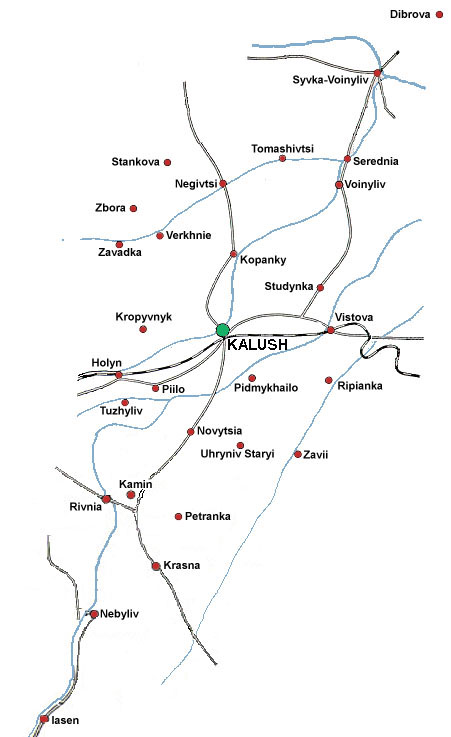|
|
The earliest known mention of Kalush is the accounting of a settlement of that name in a Halychyna chronicle dated May 27, 1437 and until mid of the 16th century was part of Halych Land. Kalush was incorporated as a city in 1549 by Mikołaj Sieniawski on the authority of the Polish Crown. The city was part of the Polish-Lithuanian Commonwealth, Austria-Hungary and Second Polish Republic. The city still contains an old rathaus which declared as the National Landmark of Architecture #591. The previous rathaus was destroyed during the Khmelnytsky Uprising. The new rathaus served as a town hall and a directory of agriculture since the 20th century. The conditions of the landmark in 2010 were terrible and the rathaus required some major renovations. In the city is a mount Vysochanka named after a colonel of Lysyanka Regiment during the Cossack Hetmanate and a leader of local uprising in 1648 Semen Vysochan. At the start of the 19th century in the city was established a bell-making factory of Felczynski Brothers.
During the years of World War II the residents of the city witnessed many ethnocides. In 1940, the Soviets forced inhabitants of Kalush to leave the town and forcefully moved them to Siberia, many of whom were Polish nationality. In 1941, some of the Poles who survived the Soviet labour camps became part of Anders Army and some of these were selected to join the Polish Air Forces in France and Great Britain. Then, in late 1941 and 1942, Jewish inhabitants of Kalush were murdered by the Germans. Since the 16th century, a Jewish community had flourished in the city; however, in 1941, while under Nazi control, that community was virtually eliminated.
Kalush, Ukraine
Extract from Wikipedia, the free encyclopedia http://en.wikipedia.org/wiki/Kalush,_Ukraine
|
Kalush (Kalusz): District center circa 1900, includes a military garrison.
Information and map courtesy of the Ukrainian Cultural Heritage Village Research Program.
|
Area: 3614 hectares
Houses: 909
Total population: 7829
(male): 3689
(female): 4140
Religious affiliation:
Catholic: 1040
Greek Catholic: 2439
Jewish: 4323
Other: 27
|
Animals:
Horses: 237
Cattle: 1210
Sheep: 0
Pigs: 716
|
Land Use:
Arable field: 1707 hectares
Meadows, pastures: 800 hectares
Gardens: 218 hectares
High meadows, pastures: 770 hectares
Forest: 278 hectares
|
Primary language of Conversation:
German: 176
Ukrainian ("Ruthenian"): 2391
Polish: 5255 |
 |
Comprised of the villages of:
Babyn, Bania, Berezhnytsia Shliakhetska, Berlohy, Bolokhiv, Dibrova, Dobrovliany, Dovhe-Kaluske, Dovhyi Voinyliv, Dovpotiv, Dovzhka, Dubovytsia, Hrabivka, Holyn, Humeniv, Iasen, Iavorivka, Kadobna, Kalush, Kalush Novyi, Kamin, Khotyn, Kopanky, Kotiatyche, Krasna, Kropyvnyk, Landestreu, Luka, Ldziany, Maidan, Medynia, Moshkivtsi, Mostyshche, Mysliv, Nebyliv, Negivtsi, Novytsia, Perekosy, Perevozets, Petranka, Pidhirky, Pidmykhailo, Piilo, Pryslop, Ripianka, Rivnia, Serednia, Slyvky, Slobidka, Sloboda-Nebylivska, Sloboda-Rivnianska, Stankova, Studynka, Syvka-Kaluska, Syvka-Voinyliv, Tomashivtsi, Topilske, Tsvitova, Tuzhyliv, Ugartsthal, Uhryniv Serednyi, Uhryniv Staryi, Verkhnie, Vistova, Voinyliv, Zahorzhe, Zavadka, Zavii, Zbora. |
YIZKOR Book
Translation of Kalusz; hayeha ve-hurbana shel ha-kehila / Kalush; The life and Destruction of the Community
 |
 The town I thought I knew
The town I thought I knew
Bernard Dichek travels to his father's shtetl in Kalusz, Ukraine, and searches for its Jewish past.
Article in Jersulem Report October 7, 2013. View movie was made based on his visit and a film trailer that includes contemporary town and area views can be viewed (LINK to to trailer)
|
|




